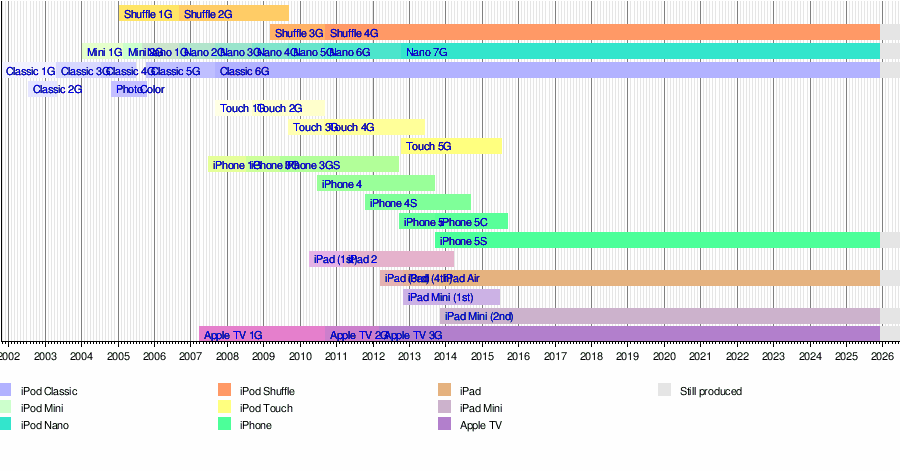- This page was last modified on 17 October 2025, at 10:18. Suggest an edit.
iPod touch facts for kids
 |
|

|
|
| Developer | Apple Inc. |
|---|---|
| Manufacturer | Foxconn |
| Release date |
May 28, 2019 (current generation)
September 14, 2007 (1st generation) |
| Units sold | 400 million as of December 2025 (since September 2007) |
| Operating system | iOS |
| Power | 3.7 V rechargeable lithium-ion battery, 3.8 Wh, 1030 mAh; audio: 40 hours; video: 8 hours |
| CPU | ARM Cortex-A9 Apple A5 dual-core 1 GHz (underclocked to 800 MHz) |
| Memory | 512 MB DRAM |
| Storage | 8, 16, 32, or 64 GB flash memory |
| Display | 4 in (102 mm), 800:1 contrast ratio (typical), 500 cd/m2 max. brightness (typical), Fingerprint-resistant oleophobic coating on front , 1136×640 px at 326 PPI |
| Input |
Multi-touch touchscreen display
ambient light sensors (except 5th generation) volume buttons microphone built in speaker voice control 3-axis accelerometer, gyroscope |
| Camera |
Rear: HD video recording 1080p up to 30 frames/s with audio
Aperture f/2.4 Facial recognition (stills only) Panorama 5 MP back-side illuminated sensor Front: FaceTime HD camera with 1.2 MP HD video recording 720p up to 30 frames/s with audio |
| Connectivity | |
| Online services | App Store, iTunes Store, iBookstore, iCloud, Passbook |
| Dimensions | 123.4 mm (4.86 in) H 58.6 mm (2.31 in) W 6.1 mm (0.24 in) D |
| Weight | 88 g (3.1 oz) |
| Related articles | List of iOS devices |
The iPod touch was a popular portable device made by Apple Inc.. It was first shown to the public on September 5, 2007. The iPod touch was well-known for its touch screen, which allowed users to control it by tapping and swiping.
It could connect to the internet using Wi-Fi. This allowed users to browse the web with Safari and watch videos on YouTube. You could also buy music from the iTunes Store. The iPod touch came with different storage sizes, like 8 GB, 16 GB, 32 GB, or 64 GB.
The iPod touch had a similar touch screen to the iPhone. It also had a physical "home" button below the screen. The main screen showed icons for apps like Music, Videos, Photos, and iTunes. Other apps included Safari, Calendar, Contacts, Clock, Calculator, and Settings.
The iPod touch was the last iPod model still being made by 2017. The iPod nano and iPod shuffle were stopped that year.
Contents
Different iPod Touch Models
The iPod touch came in several different versions, or "generations," over the years. Each new generation brought improvements and new features.
| Model | Picture | Storage Size | RAM | Connection | Release Date | Minimum Software Needed | Battery Life (hours) |
|---|---|---|---|---|---|---|---|
| 1st generation |  |
8 GB 16 GB 32 GB |
128 MB | USB via dock connector | iPhone OS 1.1: September 14, 2007 iPhone OS 1.1.3: January 30, 2008 32 GB: February 5, 2008 | Mac: 10.4 or later Win: XP, Vista, 7 |
audio: 22 video: 5 |
| The first iPod Touch came out on September 5, 2007. It was the first iPod with Wi-Fi and a multi-touch screen. It had the Safari web browser and could connect wirelessly to the iTunes Store and YouTube. Later, 16 GB and 32 GB versions were added. To get App Store access, you had to pay for an upgrade. | |||||||
| 2nd generation |  |
8 GB 16 GB 32 GB |
128 MB | USB via dock connector | iPhone OS 2.1 (8 GB, 16 GB, 32 GB): September 9, 2008 iPhone OS 3.1 (8 GB only): September 9, 2009 | Mac: 10.4 or later Win: XP, Vista, 7 |
audio: 36 video: 6 |
| The second iPod Touch was revealed on September 9, 2008. It had a new curved chrome back, Nike+ features, volume buttons, and a built-in speaker. It came with iPhone OS 2.0 and App Store access. Bluetooth support was added later with iPhone OS 3.0. This model looked very similar to the iPhone 3G from the front. It also allowed audio input if you plugged in headphones with a microphone. | |||||||
| 3rd generation |  |
32 GB 64 GB |
256 MB | USB via dock connector | September 9, 2009 | Mac: 10.4 or later Win: XP, Vista, 7 |
audio: 30 video: 6 |
| The 32 GB and 64 GB models of the third generation iPod Touch had better internal parts, like the iPhone 3GS. They included voice control and came with iPhone OS 3.x. These models also came with earphones that had a microphone. Apple continued to sell the 8 GB second-generation model alongside these new third-generation devices. | |||||||
| 4th generation |  |
8 GB 16 GB 32 GB 64 GB |
256 MB | USB via dock connector | Black: September 1, 2010 White: October 12, 2011 | Mac: 10.5 or later Win: XP, Vista, 7 |
audio: 40 video: 7 |
| Apple showed off the fourth generation iPod Touch on September 1, 2010. It had a front-facing camera for FaceTime video calls and a Retina display (a very sharp screen). It could record 720p video and take photos with a back camera. It also had Apple's A4 chip, a built-in microphone, and a 3-axis gyroscope for motion sensing. In October 2011, a white color option was added. This model could be updated up to iOS 6.1.6. | |||||||
| 5th generation |  |
32 GB 64 GB |
512 MB | USB via Lightning connector | October 12, 2012 | Mac: 10.6.8 or later Win: XP (SP3), Vista, 7 |
audio: 40 video: 8 |
| Apple introduced the fifth generation iPod Touch on September 12, 2012. It had a larger 4-inch screen, an IPS display (which means colors look good from different angles), and could record 1080p video. It also featured Apple's A5 chip and supported Siri, Apple's voice assistant. This model came in many colors like Slate, Silver, Pink, Yellow, Blue, and Product Red. In 2014, a 16 GB model was released with a rear camera and more color options, and prices for all models were lowered. | |||||||
Setting Up Your iPod Touch
Before October 12, 2011, when you first got an iPod Touch, you had to connect it to a computer. You needed to have iTunes installed on a Mac OS X or Microsoft Windows computer. The iPod touch would show a "cable to iTunes" picture until it was connected and recognized by iTunes. You also needed a USB 2.0 port on your computer.
However, after October 12, 2011, new iPods came with iOS 5 already installed. This meant you could set up your iPod wirelessly without needing a computer. You could also sync and back up your data using Apple's iCloud service, which stores your information online.
The official requirements for the iPod touch were:
- A computer running either:
- Mac OS X 10.4.10 or later
- Microsoft Windows XP (Home or Professional x32 Edition) with SP2, or Microsoft Windows Vista (32 bit OS only )
- iTunes 7.4 or later
- An available USB 2.0 port
- Internet access
Connecting with Wi-Fi
The iPod touch included Wi-Fi (802.11b/g) for internet access. Just like the iPhone, it had the Safari web browser and the YouTube app. The Wi-Fi also let you buy music directly from the iTunes Store.
Apps from Other Companies
On October 17, 2007, Steve Jobs, the co-founder of Apple, announced that a software development kit (SDK) for the iPhone would be available in February 2008. This SDK would allow other companies to create apps for the iPhone. This also applied to the iPod touch.
Even before the official SDK, some users found ways to "jailbreak" their iPod touch. This allowed them to install apps not approved by Apple. One popular method used a trick with TIFF files in the web browser to install these unofficial programs.
Comparing to the iPhone
Early reviews of the iPod touch pointed out some differences compared to Apple's iPhone. One common complaint was that the iPod touch didn't have apps for email, maps, or checking stock prices, which the iPhone had. Another difference was that the first iPod touch didn't have physical buttons for volume control. Instead, you had to double-click the home button to bring up an on-screen volume control.
The first iPod touch also didn't have external speakers, a built-in camera, or Bluetooth. However, the second generation and later models added external speakers and Bluetooth. The fourth generation, released in September 2010, was the first iPod touch to have the sharp Retina display and two built-in cameras for FaceTime calls and taking photos or videos.
Some people thought Apple left out these features on purpose to make the iPod touch different from the more expensive iPhone. Others argued that the iPod touch didn't need these features because it was an iPod (for music and media), not a mobile phone.
By the time the 5th-generation iPod touch came out, it had many of the same features as the iPhone. However, it was generally less powerful, had a simpler camera, didn't have built-in GPS, and couldn't make phone calls. But it was also cheaper and thinner than the iPhone, making it easier to carry around.
Technical Details
Here are some of the technical details of the iPod touch, as listed by Apple:
- Screen material: Glass
- Screen size: 8.9 cm (3.5 in)
- Screen resolution: 480×320 pixels at 163 ppi
- How you interact: Multi-touch screen
- Operating system: iOS
- Storage: 8, 32, or 64 GB flash memory
- CPU: 1.0 GHz ARM Cortex-A8
- RAM: 256 MB
- Wi-Fi (802.11 b/g)
- Battery: Built-in rechargeable battery. It could play videos for up to 7 hours and audio for up to 40 hours.
- Size: 110×61.8×8 mm (4.3×2.4×0.31 in)
- Weight: 120 grams (4.2 ounces)
- Direct iTunes Wi-Fi store access
- Wide screen video playback
- Built-in Safari web browser and YouTube app
Timeline

Sources: Apple press release library, Mactracker Apple Inc. model database

